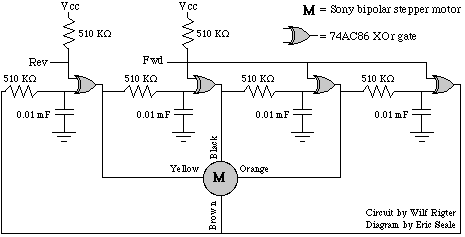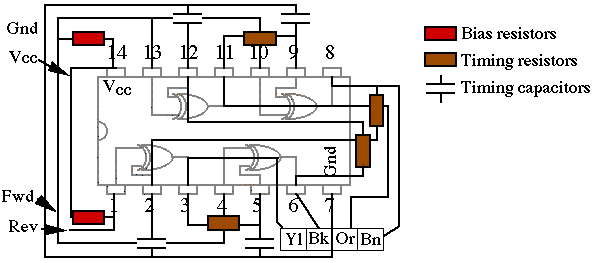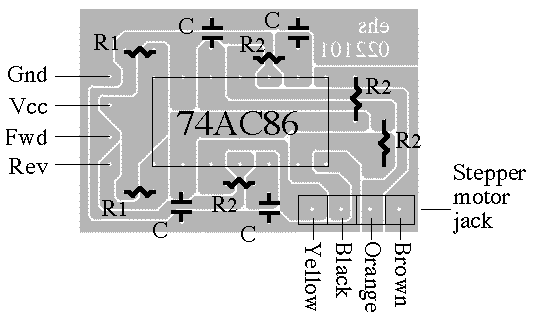|
|
The BEAM Circuits Collection is a BEAM Reference Library site.
Wilf's Nu-based stepper motor drive
circuit
The NuStepper
Wilf Rigter came up with a nifty (single-IC!) circuit to drive the bipolar stepper motor that's a part of floppy drives:

I've reproduced Wilf's own description of this circuit from here:
|
Note that the NuCore posting that Wilf refers to is archived here, while the original (with ASCII art) NuRing posting reproduced above is archived here.
I'll be updating this page as I (get time to...) experiment with Wilf's circuit over the coming months.
![]() Warning
-- circuit under development; material that follows may not
be fully accurate!
Warning
-- circuit under development; material that follows may not
be fully accurate!
Here's a different layout of the NuStepper circuit diagram, with traces and other components overlaid on the 74AC86 chip diagram:

The four boxes in the lower right corner (Yl / Bk / Or / Bn) represent the pins on the stepper motor plug, and the corresponding colors of the stepper motor's wires.
|
Here's the life-size PCB "artwork" for Wilf's NuStepper. A higher-res (x8) version is available here. |
 |
|
Coming soon -- pictures of a populated NuStepper PCB!
|
|
Here's how to lay out the components on a NuStepper PCB (this image is 4 times the size of the actual PCB since this is a fairly small board):

Parts list
|
Part ID |
# required |
Description |
|
R1 |
2 |
Input ("bias") resistors; 510 KOhm nominally |
|
R2 |
4 |
Timing resistors |
|
C |
4 |
Timing capacitors |
|
J |
1 |
Stepper motor jack (salvaged from the same floppy drive that the motor came from) |
|
74AC86 |
1 |
Quad XOR IC |
The values for C and R2 determine the neuron firing times
When I build up this card, the 74*86 IC is "socketed," both to protect the IC during soldering, and to allow for experimentation with IC subfamily. Similarly, the timing resistors and timing capacitors are plugged into individual sockets to allow for tinkering with circuit timing (i.e., motor rotation speed).
|
|
||
|
|
This page was last updated on |
|